Berwick-upon-Tweed
| Berwick-upon-Tweed | |
| Northumberland | |
|---|---|
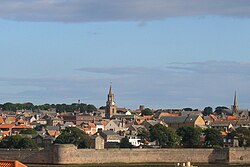 View over Berwick-upon-Tweed town centre | |
| Location | |
| Grid reference: | NT995525 |
| Location: | 55°46’16"N, 2°0’25"W |
| Data | |
| Population: | 11,665 (2001) |
| Post town: | Berwick-upon-Tweed |
| Postcode: | TD15 |
| Dialling code: | 01289 |
| Local Government | |
| Council: | Northumberland |
| Parliamentary constituency: |
Berwick-upon-Tweed |
Berwick-upon-Tweed or simply Berwick is a town in the county of Northumberland and is the northernmost town in England, on the east coast at the mouth of the River Tweed. It is situated two and a half miles south of the boundary with Berwickshire, from which womb it was untimely ripp'd. It was indeed before war and conquest separated it from its county, the county town of Berwickshire. The lands appertaining to Berwick beyond the town itself are known as the Liberties of Berwick.
The town had a population of 11,665 at the time of the 2001 census.
Founded during the time of the English kingdom of Northumbria, the area was central to historic border war between the Kingdoms of England and Scotland for centuries; the last time it changed hands was when England reconquered it in 1482. Berwick remains a traditional market town and also has some notable architectural features, in particular its defence ramparts and barrack buildings.
The town area now encompasses more than ancient Berwick-upon-Tweed but on the south side of the Tweed are Tweedmouth and Spittal on the coast. The Liberties beyond the town are largely devoid of villages of any size.
The Mayor of Berwick upon Tweed holds an ancient privilege: in England the rules of precedence give place amongst mayors first to the Lord Mayor of London, then to York, then to Berwick-upon-Tweed.
Name
The origin of the town's name is Old English or perhaps Norse; the element "wick" is from "wic" meaning a village in English though the Norse "vik" has been suggested, meaning a bay or indeed village. The first element is also ambiguous, and may refer to either barley (bere) or the headland ("bar") which cuts across the Tweed estuary. Another interpretation claims "Corn Farm" as the meaning of Berwick.[1]
William Camden, however, derives the name as meaning a dependent village, citing a number of districts named the "berwick" of a parent borough, and he suggests that it was once a dependency of Coldingham Priory. Another of Camden's suggestions was that the name is shortened from Beornica wic, meaning "Village of the Bernicians".
History
Early history and Northumbrian rule
In Roman and sub-Roman days, all this land is believed to have belonged ether to the Brigantes or Bryneich. In the sixth century or thereabouts, the land was conquered and settled by Anglo-Saxons, the ancestral English, who created the kingdom of Bernicia, which united with the Kingdom of Deira]] to form the Kingdom of the Northumbrians. Nothing is known of Berwick in this period, though it is close to centres of power; nearby Bamburgh was a Deiran capital and later seat of the High Reeves who maintained English rule in the unconquered parts of Northumbria until the Norse had been driven out of the land.
In either 973[2] or 1018 Northumbria north of the Tweed (known as Lothian) was ceded to Scotland. In 1018 the Scots defeated the Northumbrians at the Battle of Carham, which occurred across the River Tweed opposite Coldstream to secure possession of Lothian.
Middle Ages and Scottish rule
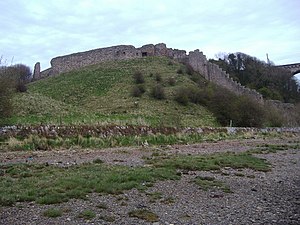
Berwick's history until the early modern period revolved around its strategic position on the border of Scotland and England. Centuries of war between the two nations and the wealth of the town as a port led to a succession of raids, sieges and occupations. Between 1147 and 1482 the town changed hands between England and Scotland more than 13 times, and was the location of a number of momentous events in the border wars. One of the most brutal sackings was by King Edward I of England in 1296, and set the precedent for bitter border conflict in the Scottish Wars of Independence.
In the 13th century Berwick was one of the most wealthy trading ports in Scotland, providing an annual customs value of £2,190, equivalent to a quarter of all customs revenues received north of the border. A contemporary description of the town asserted that "so populous and of such commercial importance that it might rightly be called another Alexandria, whose riches were the sea and the water its walls."[3] Amongst the town's exports were wool, grain and salmon, while merchants from Germany and the Low Countries set up businesses in the town in order to trade.
The Scots also had a mint at Berwick, producing Scottish coinage. In contrast, under English rule, Berwick was a garrison town first, and a port second. In around 1120, King David I of Scotland made Berwick one of Scotland's four royal burghs, which allowed the town's freemen a number of rights and privileges.
Berwick had a mediæval hospital for the sick and poor which was administered by the Church. A charter under the Great Seal of Scotland, confirmed by King James I of Scotland, grants the king's chaplain "Thomas Lauder of the House of God or Hospital lying in the burgh of Berwick-upon-Tweed, to be held to him for the whole time of his life with all lands, teinds, rents and profits, etc., belonging to the said hospital, as freely as is granted to any other hospital in the Kingdom of Scotland; the king also commands all those concerned to pay to the grantee all things necessary for the support of the hospital. Dated at Edinburgh June 8, in the 20th year of his reign."
Civic history
Berwick became a Royal Burgh under King David I of Scotland. Its first known mayor was Robert Barham, who was certainly mayor in 1238 and in 1249, though the years between are unknown. Barham’ family owned considerable properties in the Berwick area and his brother David was a great friend of King Alexander II of Scotland. It is from Berwick’s status as a Scottish royal burgh that the Mayor has purple ceremonial robes instead of the red robes expected of an English mayor.
The Guild of Freemen Statutes ordained that Berwick be governed by 24 good, discreet and trustworthy men, plus the Mayor, plus four bailiffs.
The office of Mayor of Berwick-upon-Tweed was interrupted by local government changes, but is continued in the town mayor, appointed by the town council since it was established in 2008.
Struggles for control of Berwick
- 1018: Held by Malcolm II of Scotland after the Battle of Carham
- 1174: Berwick was paid as part of the ransom of William I of Scotland to Henry II of England
- 1190s: Sold to Scotland by Richard I of England, to raise money to pay for Crusades
- 1216: Town destroyed by King John of England, who attended in person the razing of the town with some barbarity
- 1296: Captured by Edward I of England
- 1318: Captured by the Scots
- 1333: Captured by the English, after the Battle of Halidon Hill
- 1461/2: Captured by the Scots
- 1482: captured by Richard Duke of Gloucester, the future King Richard III
- 1603: King James VI & I enters Berwick and declares it part of the King's united realm
Eddington remarks, "Berwick, by the middle of the 13th century, was considered a second Alexandria, so extensive was its commerce." However, Berwick appended its signature to the treaty of King John of Scotland with France, England's old enemy, and on 30 March 1296, Edward I stormed Berwick after a prolonged siege in 1296, sacking it with much bloodshed. His army slaughtered almost everyone who resided in the town, even if they fled to the churches, some eight thousand inhabitants being put to the sword. "From that time", states Eddington, "the greatest merchant city in Scotland sank into a small seaport."
Edward I went again to Berwick in August 1296 to receive formal homage from some 2,000 Scottish nobles, after defeating the Scots at the Battle of Dunbar in April and forcing John I of Scotland (John Balliol) to abdicate at Kincardine Castle the following July. The first town walls were built during the reign of Edward I. The "homage" was not received well, and the Ragman Roll as it was known, earned itself a name of notoriety in the post-independence period of Scotland. Some believe it to be the origin of the term "rigmarole", although this may be a folk etymology.
An arm of William Wallace was displayed at Berwick after his execution and quartering on 23 August 1305. In 1314 Edward II of England mustered 25,000 men at Berwick, who later fought at the Battle of Bannockburn, the decisive defeat of the English in the wars.
On 1 April 1318, Berwick was recaptured by the Scots. Sir Pierce Spalding delivered the town up to Thomas Randall, Earl of Murray on 2 April 1318 in consideration of lands given him in Angus,[4] Berwick Castle was also taken after a three-month siege. In 1330 "Domino Roberto de Lawedre" of The Bass, described as Custodian or Keeper of the Marches and the Castle of Berwick-upon-Tweed, received, apparently upon the termination of his employment there, £33 6s 8d, plus a similar amount, from the Scottish Exchequer.[5]
The English retook Berwick some time shortly after the Battle of Halidon Hill in 1333. In October 1357, a treaty was signed at Berwick by which the Scottish estates undertook to pay 100,000 marks as a ransom for David II of Scotland, who had been taken prisoner at the Battle of Neville's Cross on 17 October 1346.
In 1461/2 Berwick was recovered by the Scots and Robert Lauder of Edrington was put in charge of the castle.[6]
On 3 February 1478 Robert Lauder of The Bass and Edrington was again appointed Keeper of the castle at Berwick-upon-Tweed with a retainer of £250 per annum. He continued in that position until the last year of Scottish occupation, when Patrick Hepburn, 1st Lord Hailes, had possession.
English rule
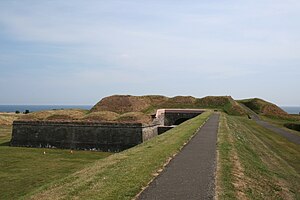
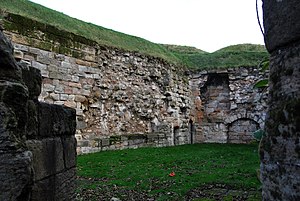
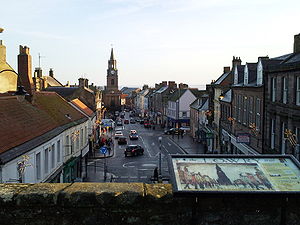
In 1482 the town was captured by Richard Duke of Gloucester, the future King Richard III, although not annexed to England. England ruled the town from that day forth until the union. (Lord Mansfield noted in his judgment in Campbell v Hall that until the reign of King James I, Berwick was governed by royal decrees and not by English law.)
In 1551, the town was made a county corporate.
During the reign of Queen Elizabeth I of England, vast sums – one source reports "£128,648, the most expensive undertaking of the Elizabethan period"[7] – were spent on its fortifications, in a new Italian style (trace italienne), designed both to withstand artillery and to facilitate its use from within the fortifications. Sir Richard Lee designed some of the Elizabethan works.[8] Although most of Berwick Castle was demolished in the 19th century to make way for the railway, the military barracks remain, as do the town's rampart walls – one of the finest remaining examples of its type in the country.
Union in the King's person
In 1603, Berwick was the first English town to greet James VI of Scotland on his way to being crowned James I of England. Upon crossing Berwick Bridge, King James is supposed to have declared that the town neither belonged to England nor to Scotland but was part of the united Crown's domain. The accession of King James rendered the defences of Berwick purposeless, and the town which welcomes the King with a loud salute of cannon soon had its fortress closed down.
In 1639 the army of Charles I faced that of General Alexander Leslie at Berwick in the Bishops' Wars, which were concerned with bringing the Presbyterian Church of Scotland under Charles's control. The two sides did not fight, but negotiated a settlement, "the Pacification of Berwick", in June, under which the King agreed that all disputed questions should be referred to another General Assembly or to the Scottish Parliament.
Holy Trinity Church was built in 1650–52, on the initiative of the governor, Colonel George Fenwicke. Churches of the Commonwealth period are very rare. The church has no steeple, supposedly at the behest of Oliver Cromwell, who passed through the town in 1650 on his way to the Battle of Dunbar of 1650.
The Union
Contention about whether the town belonged to England or Scotland was ended in 1707 by the union of the two. Berwick is now a town of the United Kingdom, and remains within the laws and legal system of England and Wales.
William Camden in Britannia records a poem by Maister John Jonston about Berwick:
Afront the bound of Scotish ground, where staid the furious broile
Of English warres, and Nations both were put to equall toile.
Now wonne, then lost, a thousand turnes it felt of fortunes will,
After so many miseries, wonder it standeth still.
And still it stands, although laid wast it were and desolate,
Yet alwaies after every fall it rose to firmer state.
So that for strength, best fensed townes it matcheth at this day.
The Citizens were souldiers all, and serv’d in wars for pay.
But after service long perform’d and hard adventures past,
Of joy and mirth the gladsome signes it putteth forth at last.
And now her ancient honor she doth vaunt in happy plight,
When to her Sovereigne Lord she yeelds all service due by right,
Whose blessed Crowne united hath Great Britain now at last,
Whereby her head she lifts on high, since quarels all be past.
Economy
Slightly more than 60% of the population is employed in the service sector, including shops, hotels and catering, financial services and most government activity, including health care. About 13% is in manufacturing; 10% in agriculture, and 8% in construction.[9] Some current and recent Berwick economic activities include salmon fishing, shipbuilding, engineering, sawmilling, fertilizer manufacture, and the manufacture of tweed and hosiery.
Berwick Town Centre comprises the Mary Gate and High Street where many local shops and some retail chains exist. There is a small supermarket in the vicinity too. A new office development is due to be built in the Walker Gate.[10]
Transport
The old Great North Road passes through Berwick. The modern A1 goes around the town to the west. The town is on the East Coast Main Line railway, and has a station. A small seaport at Tweedmouth facilitates the import and export of goods, but provides no passenger services.
Culture
Berwick dialect
The local dialect, known as "Berwick", has elements of Lowland Scots and the North East English dialect. The accent appears to be leaning more and more towards the south with each generation.[11]
Sport
The town is represented by Berwick Rangers FC, who play in the Scottish Football League to make travelling shorter. The home stadium of Berwick Rangers is Shielfield Park.
The town also has a rugby union side, Berwick RFC who play in Scottish Rugby Union's East Regional League Division 1.
Motorcycle speedway has taken place in Berwick in two separate eras. The sport was introduced to Shielfield Park in May 1968. A dispute between the speedway club and the stadium owners ended the first spell. The sport returned to Shielfield Park in the mid-1990s. The lack of a venue in the town saw the team move to a rural location called Berrington Lough. The team, known as The Bandits, have raced at all levels from First Division to Conference League (first to third levels).
Berwick is unique for an English town in that both their football and rugby teams play their matches in the Scottish leagues, although at one point the Scottish town of Gretna used to play games in the English football leagues.
War with Russia
There is a curious apocryphal story that Berwick is (or recently was) technically at war with Russia. The story tells that since Berwick had changed hands several times, it was traditionally regarded as a special, separate entity, and some proclamations referred to "England, Scotland and the town of Berwick-upon-Tweed". The local tale tells that in 1853, when the Crimean War began, the declaration of war against Russia was eissued in the name of "Victoria, Queen of Great Britain, Ireland, Berwick-upon-Tweed and all British Dominions". However, when the Treaty of Paris was signed in 1856, "Berwick-upon-Tweed" was left out, which meant that Berwick remained at war with the Russian Empire.
The tale gained legs when George Hawthorne wrote in The Guardian (on 28 December 1966) that the London correspondent of Pravda had visited the Mayor of Berwick and the two made a mutual declaration of peace. Knox said "Please tell the Russian people through your newspaper that they can sleep peacefully in their beds."
In truth, Berwick was not mentioned in the Treaty of Paris, but it was not mentioned in the declaration of war either, which of course was by the whole British Empire. In the 1970s the BBC programme Nationwide bestirred itself to investigate the story and dismissed it but a happy local myth of stalwart Berwick holding out alone against the eastern hordes is hard to let go, and even now many will assert that a correspondet from Pravda had no right to make a peace treaty and their war continues.
Sights of Berwick
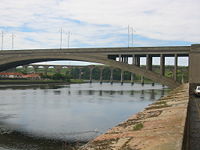
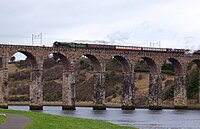
- Berwick Barracks, now maintained by English Heritage, and built between 1717 and 1721, the design attributed to Nicholas Hawksmoor.
- Berwick-upon-Tweed Town Walls - the ramparts or defensive wall around the town centre.
- The Old Bridge, 15-span sandstone arch bridge measuring 1,164 feet in length, built between 1610 and 1624, at a cost of £15,000: once part of the main route from London to Edinburgh ordered ordered by James VI and I.
- The Royal Border Bridge, designed and built under the supervision of Robert Stephenson in 1847 at a cost of £253,000, is a 720-yard-long railway viaduct with 28 arches, carrying the East Coast Main Line 126 feet above the River Tweed. It was opened by Queen Victoria in 1850.
- The Royal Tweed Bridge, built in 1925 and in its time having the longest concrete span in the country at 361 feet, was originally designed to carry the A1 road across the Tweed; the town now has a road bypass to the west.
- The Union Bridge (five miles upstream), the world's oldest surviving suspension bridge.
- The Guildhall, built in 1750 in a Classical style, and formerly housing the town's prison on the top floor.
- Berwick Parish Church, unique for having been built during the Commonwealth of Oliver Cromwell. The building, constructed around 1650 using stone from the 13th century castle (parts of which still stand by the railway station), began as a plain preaching box, with no steeple, stained glass or other decorations. Much altered with a conventional interior layout, contents include a pulpit thought to have been built for John Knox during his stay in the town.
- Dewars Lane Runs down Back Street just off Bridge Street, and, like other Berwick locations, was painted by LS Lowry. The painter was a frequent visitor to Berwick, especially in the 1930s, when he stayed at the Castle Hotel.[12]
Outside links
| ("Wikimedia Commons" has material about Berwick-upon-Tweed) |
- Official Berwick-upon-Tweed tourist information
- Explore Berwick
- Visit Northumberland
- The Lowry Trail around the town
- Images and the history of Berwick's shipbuilding
- Tide times for Berwick
- Berwick Town Council
- A photographic tour of Berwick
- Berwick Photos
References
- ↑ "Berwick upon Tweed: a town of two nations". http://www.oxforddnb.com/public/themes/92/92711.html. Retrieved 2008-03-09.
- ↑ Anderson, Marjorie O., Kings and Kingship in Early Scotland, (Edinburgh, 1973)
- ↑ www.thenortheast.fsnet.co.uk
- ↑ Wallis' Northumberland, England, vol. 2, p. 435: "Berwick Castle
- ↑ Stuart, John, LL.D., and Burnett, George, Lord Lyon King of Arms, The Exchequer Rolls of Scotland, vol.1, 1264–1359, Edinburgh, 1878, pps 279,313,339
- ↑ Scott: "About 1462 Berwick Castle was put into the hands of Robert Lauder of Edrington, an important official and soldier in Scotland at that time. Lauder kept his position uninterruptedly until 1474 when he was succeeded by David, Earl of Crawford. In 1464 Robert Lauder was paid £20 for repairs made to Berwick Castle."
- ↑ www.berwick.org.uk
- ↑ Calendar State Papers Foreign Elizabeth 1559–1560, Longman (1865), no. 1064, "setting forth the device"
- ↑ Employment
- ↑ Berwick Advertiser
- ↑ Rhoticity in four Scottish/English border localities "could be argued on the basis of the data in Watt (2006) that Berwick English is increasingly convergent with other non-rhotic English varieties in northern England, and increasingly divergent from Scottish varieties with which it has traditionally shared numerous properties" April 2008.
- ↑ www.familytraits.co.uk
Books
- Fuller, John: The History of Berwick upon Tweed (Edinburgh, 1799)
- Scott, John (1888). Berwick-upon-Tweed, The History of the Town and Guild. London.
- Burnett, George (ed.) (1886). "vol. IX: 1480–1487". The Exchequer Rolls of Scotland. Edinburgh. pp. 63/4. 81, 145 & 157. Record that payments were made to Robert Lauder of The Bass as Captain and Keeper of the castle at Berwick-upon-Tweed in 1480 and 1481.
- Eddington, Alexander (1926). Castles and Historic Homes of the Border (1st ed.). Edinburgh & London. pp. 58–59.
- Hewlings (1993). "Hawksmoor's Brave Designs for the Police". in Bold, J; Cheney, E. English Architecture Public and Private: Essays for Kerry Downes. London: Hambledon Press. pp. 214–229. ISBN 1-85285-095-7
